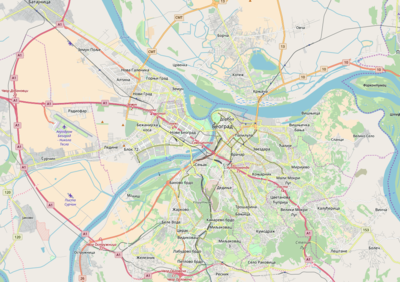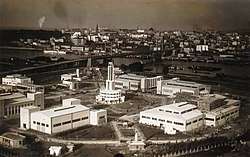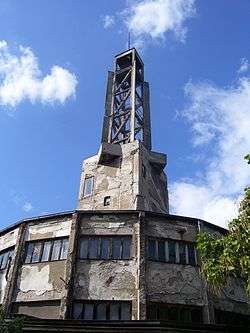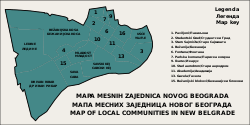Staro Sajmište
Staro Sajmište (Serbian Cyrillic: Старо Сајмиште, romanized: Old Fairground) is an urban neighborhood of Belgrade, the capital of Serbia. It is located in Belgrade's municipality of Novi Beograd and it was the site of the World War II Sajmište concentration camp (1941–1944) under control of the Independent State of Croatia (NDH).
Staro Sajmište Старо Сајмиште | |
|---|---|
| Etymology: Old Fairground | |
 Staro Sajmište Location within Belgrade | |
| Coordinates: 44°48′46″N 20°26′37″E | |
| Country | |
| Region | |
| Municipality | New Belgrade |
| Local community | Staro Sajmište |
| Population (2011) | |
| • Total | 1,862 |
| Time zone | UTC+1 (CET) |
| • Summer (DST) | UTC+2 (CEST) |
| Area code | +381(0)11 |
| Car plates | BG |
Location
Staro Sajmište is located in the Novi Beograd's Block 17, between the street of Zemunski put (extension of the Old Sava Bridge), the Mihajlo Pupin boulevard (extension of the Branko's bridge) and the Sava river. It extends into the non-residential neighborhood of Ušće on the north and into the newly developed Savograd on the west. Sajmište street curves within the settlement. In the south it extended into the former informal settlement Cardboard city, and further into industrialized neighborhood of Savski Nasip.[1][2]
Although this is what is usually considered as the Staro Sajmište, local community (sub-municipal administrative unit) of the same name also includes the entire Block 18 to the south, which is located between the streets of Vladimira Popovića and Zemunski put, Gazela Bridge and the left bank of the Sava.[3]
History
Before 1941

In the period between the World Wars, settlements began to form on the left bank of the Sava river, closer to Belgrade, as the only existing settlement on the marshy territory of today's Novi Beograd at that time was the village of Bežanija, quite far away from Belgrade. Construction of the King Alexander Bridge lasted from 1930 to 1934, and the filling and embankment of the Sava bank began in 1936.[4] In the 1930s members of Belgrade's affluent elite began to buy land from the villagers of Bežanija, which at that time, administratively spread all the way to the King Alexander Bridge, which was a dividing point between Bežanija and Zemun. From 1933 a settlement, consisting mostly of individual villas, began to develop. Also, a group of White Russian emigrants built several small buildings, mostly rented by the carters who carried goods across the river. As the settlement, which became known as New Belgrade, was built without building permits, authorities threatened to demolish it, but in 1940 government officially "legalized the informal settlement of New Belgrade".[5] Prior to that, the city already semi-officially recognized the new settlement, as it helped with building its streets and pathways. By 1939 it already had several thousands inhabitants, a representative in the city hall, and was unofficially called New Belgrade.[6]
It was decided to build the fairgrounds complex adjoining to the already existing settlement. The foundation stone was ceremonially placed on 6 June 1937. It was built in three months and the facility was open on 11 September 1937. It was the site of the new Belgrade fair (hence the name) with modern and artistic buildings and constructions, including high metal spike construction, which became known as the Central Tower. Designed by the architects Milivoje Tričković, Rajko Tatić and Đorđe Lukić, it was envisioned as the monumental modern complex, with the Central Tower as the domineering motif. Around it, pavilions for the exhibitions were built: five Yugoslav, one for the “Nikola Spasić Foundation” and national pavilions of Italy, Czechoslovakia, Romania, Hungary and the Dutch company Philips. The complex included: 17,000 m2 (180,000 sq ft) of roofed exhibition space, 20,000 m2 (220,000 sq ft) of open exhibition space, 25,000 m2 (270,000 sq ft) of lawns and flower beds and 22,000 m2 (240,000 sq ft) of roads and paths.[7][8]
It hosted international fairs, with task of promoting the economy of the Kingdom of Yugoslavia as well. On the first exhibition from September 1937, there were 883 exhibitors, 493 Yugoslav and 390 foreign (17 countries from Europe, America and Asia). It had 310,000 visitors, while at the 1931 census Belgrade had a population of 266,849. In September 1938 one of the exhibitions on the fair was the first presentation of television in this part of Europe (it will be 18 years before first television station in communist Yugoslavia will appear), by Philips.[7][8] The first motor show, 1938 Belgrade Car Show, was held in March 1938.[9]
Construction of Staro Sajmište was an important, almost pivotal occurrence in urban development of Belgrade at the time, not only due to its economic importance. The complex was the only fully encircled spatial unit, excelling and singling out itself compared to other social centers in the city. It also included the first planned greening of the modern New Belgrade area. The project for the greenery arrangement in the complex was done by engineer Aleksandar Krstić.[4]
War years

After the April war of 1941 when Germany and its allies occupied and partitioned the Kingdom of Yugoslavia, entire Syrmia region (including the left bank of the Sava) became part of the Independent State of Croatia where they set the Ustaše regime. Nazi secret police, Gestapo, took over Sajmište. They encircled it with several rings of barbed wire turning it into what they referred to as "collection center" – a euphemism for a prison. It eventually became a concentration camp. Until May 1942 Germans used Sajmište concentration camp to mostly kill off Jews from Belgrade and other parts of Serbia. From April 1942 onwards, Serbian prisoners were transported in from Jasenovac and Stara Gradiška concentration camps run by ISC Croatian Ustaše. Partisans captured throughout Serbia were also sent to Sajmište. Detainees were also sent in from other parts of Yugoslavia, especially Serbs after major German offensives on briefly liberated territories. Executions of captured prisoners lasted as long as the camp existed. During their heavy “Easter bombing” of Belgrade, Allied aircraft bombed Sajmište on 17 April 1944, killing some 100 inmates and inflicting heavy damage on the camp itself, destroying all the buildings except for the Spasić pavilion and the Central tower..[10][11]
Among others, prisoners included Serbian women, children and the elderly from Kozara region, entire Jewish families from Belgrade and other cities, Romani families, as well as entire Serbian populations of different Syrmian villages. November 1946 report released by Yugoslav State Commission for Crimes of Occupiers and their Collaborators claims that close to 100,000 prisoners came through Sajmište's gates. It is estimated that around 48,000 people perished inside the camp.
After 1945
After the war the settlement was totally neglected for years and gradually started falling apart. Former fair buildings were awarded to some prominent artists (painters and sculptors) as their ateliers.[11] Finally on 9 July 1987, Belgrade City Assembly decided to make Staro Sajmište a cultural site, thereby protecting it from real-estate expansion development. In 1992 city administration adopted a plan for the area covering 20.5 hectares of land and 1.4 hectares of the Sava river's aquatoria.[7] On 21 April 1995, a monument in remembrance of Sajmište victims was unveiled along Sava, one day ahead of the 50-year anniversary of Hitler admitting defeat on 22 April 1945.
However, almost nothing was done to conserve the area and today Staro Sajmište is in a very bad shape. Few remaining old artists have no resources to renovate the complex themselves and the area became the gathering site for vagrants and criminals, so the ateliers are often looted. Population of the local community was 3,147 in 1981,[12] 2,240 in 1991,[13] 2,250 in 2002[14] and 1,862 in 2011.[15]
After the new site of the Belgrade Fair was constructed on the right bank of the Sava, Sajmište became known as Staro Sajmište (old fair ground). Old sandy beach on the Sava bank in Staro Sajmište used to be called "Nica" (Nice), after kafana where the modern restaurant Ušće is located.[16]
At one point, the locality along the quay in Block 18 was chosen as the location of the new Belgrade Opera House. In November 1968, city council adopted a decision for the new opera house to be built along the river bank between the Gazela Bridge and the newly planned New Sava Bridge. The preparatory works were planned to start in 1969 and to finish by 1972 when the proper construction was to begin. The projected deadline was set in 1975. The decision was made as part of the 100th anniversary of the National Theatre in Belgrade, as Belgrade Opera, founded in 1919, is part of the theatre and shares its building. The entire project was later scrapped and neither the opera house nor the new bridge were built.[17] As of June 2019, the opera still has no building of its own.
The bank of the Sava in the neighboring Ušće, starting in 1991, became a location of numerous barges (Serbian splav, plural splavovi), which became central venues of the city's modern nightlife. From the summer of 1996, the splavovi spread along the bank of Staro Sajmište, too. Numerous shootouts in the venues, which included the river police and fatalities, ensued. Until that point, only turbo folk music was played in the venues, but the barges in Staro Sajmište were the first where "urban" splavovi appeared and the entire sub-culture originating in the venues became mainstream. This barges had "historical importance" for the expansion and acceptance of the venues as an authentic part of the Belgrade's nightlife and tourist offering. However, the constant public conflict between the cheap fun and criminal on the barges, and the solemnity of the neighborhood given its war history, continued for decades. Ultimately, all barges were moved out of Staro Sajmište by the late 2010s.[18][19]
Characteristics

As the rest of New Belgrade developed, Staro Sajmište in time became surrounded by various important economic, commercial and landmark features of the new city. They include the Ušće Tower, Ušće Park, with the skatepark, on the north; a complex of business buildings (Naftna Industrija Srbije, Huawei, Delta Holding, Genex Apartments, Savograd), hotels (Crowne Plaza Belgrade, Hyatt Regency Belgrade) and multi-purpose building of Sava Centar, on the west; industrial facilities of Savski Nasip, peninsula of Mala Ciganlija and the Bežanija winter shelter, an arm of the Sava, on the southwest.[1][2]
South of the Zemunski put, a Sajmište parking lot is located where inappropriately parked cars are tolled to. Along the quay on the bank of the Sava in Block 18, there is a Park Republika Srpska, formerly Park of the Non-aligned.
Block 18
The area of the Block 18, now a completely residential area with individual housing, was added to the project of the controversial Belgrade Waterfront. A plan for the neighborhood was adopted by the city in 2016. It was designed by Vanja Panić, Marko Vesković and Aleksandar Knežević. It includes the complete demolition of the existing urban tissue in the block, which covers an area of 46.8 ha (116 acres). An expanded promenade is planned along the Sava bank. Closer to the Gazela bridge, is the location of the future large square with new opera house, while on the other side, close to Staro Sajmište, there will be a smaller square and the national gallery. A new pedestrian bridge across the river is also planned, which will connect Block 18 directly to the rest of the Belgrade Waterfront. Four skyscrapers, not taller than 100 m (330 ft) are projected: one along the Gazela, one next to the Hyatt Regency Belgrade, and two in the center of the block. A local, circular shuttle train line is envisioned, which would also connect the neighborhood with the old section of the city across the river.[20]
In January 2019, investment company "Marera Properties" announced that the new complex would include seats of all secretariats and institutes of the state government and the city of Belgrade. Total floor area built on the 0.5 ha (1.2 acres) owned by the company's should be 350,000 m2 (3,800,000 sq ft), and was announced as Belgrade's version of The City. The basis for the project, however, must be the 2016 project and it is not clear how much of the project company plans to participate in as their plans exceed the area they can built on at the moment. Also, it is still not decided whether the lots will be sold to the company or will it lease it from the city. As of this period no works have been done and even in the best case scenario, the construction won't start before 2020.[20] Though it was reported by September 2019 that the plan is a no-go because of the other projects, the investor stated it is not giving up on this location.[21]
In the previous decades, all city plans treated this area as part of the Sava Amphitheatre, one urban unit with Savamala across the river in the old section of Belgrade. This was all changed because of the project Belgrade Waterfront which officially kept this part within its scopes, but envisioned completely independent urban development. Despite the fierce opposition of the professional architects and urbanists, city refused to organize the international design competition in 2016. Because of this, and the even stronger opposition to the Belgrade Waterfront in general, it is perceived that the conventional 2016 project was chosen to "legalize" the entire project and to appease the public.[20]
Future
In February 1992, as provided by the detailed urban plan, the neighborhood was to be fully reconstructed to its pre-war look, an idea opposed by some architects, with added memorial and commemorative objects. The entire complex was to be transformed into one large memorial, but it all remained on paper. The idea was constantly present, gaining media and political momentum in the 2010s, but as of 2018 nothing has been actually done.[22]
In November 2018 it was announced that a monument to the humanitarian Diana Budisavljević will be placed along the quay, next to the already existing memorial. Budisavljević saved 15,000 children (12,000 of which survived) from perishing in the Concentration camps in the Independent State of Croatia, operated by the Ustaše regime during World War II. City decided to erect a monument in her memory already in October 2015, but only now set the location. The monument should be finished and dedicated in the second half of 2019.[23]
References
- Tamara Marinković-Radošević (2007). Beograd – plan i vodič. Belgrade: Geokarta. ISBN 86-459-0006-8.
- Beograd - plan grada. Smedrevska Palanka: M@gic M@p. 2006. ISBN 86-83501-53-1.
- Dimitrije Bukvić, "Muke žitelja Starog sajmišta", Politika (in Serbian)
- Anica Teofilović, Vesna Isajlović, Milica Grozdanić (2010). Пројекат "Зелена регулатива Београда" - IV фаѕа: План генералне регулације система зелених површина Београда (концепт плана) [Project "Green regulations of Belgrade" - IV phase: Plan of the general regulation of the green area system in Belgrade (concept of the plan)] (PDF). Urbanistički zavod Beograda.CS1 maint: multiple names: authors list (link)
- Zoran Nikolić (9 March 2016). "Beogradske priče – Novi Beograd rođen na Starom sajmu" [Belgrade stories - New Belgrade was born at Old Fairground] (in Serbian). Večernje Novosti.
- ""Elitno" naselje "Novi Beograd" napreduje" ["Elite" settlement "New Belgrade" is progressing], Politika (in Serbian), 12 June 1939
- Daliborka Mučibabić (5 Jul 2013), "Centralna kula – stožer memorijalnog kompleksa", Politika (in Serbian), p. 19
- Ana Jovanović (11 September 2017), "Mesto za trgovinu robom i izlaganje poslovnih ponuda", Politika (in Serbian), p. 15
- Zoran Nikolić (26 December 2013). "Beogradske priče: Sajam automobila 1938" [Belgrade stories: 1938 car show]. Večernje Novosti (in Serbian).
- J. Gajić (15–16 April 2017). "Na praznik padale bombe" (in Serbian). Politika. p. 27.
- Daliborka Mučibabić (13 June 2010). "Oronuli svedok stvaranja i stradanja" (in Serbian). Politika.
- Osnovni skupovi stanovništva u zemlji – SFRJ, SR i SAP, opštine i mesne zajednice 31.03.1981, tabela 191. Savezni zavod za statistiku (txt file). 1983.
- Stanovništvo prema migracionim obeležjima – SFRJ, SR i SAP, opštine i mesne zajednice 31.03.1991, tabela 018. Savezni zavod za statistiku (txt file).
- Popis stanovništva po mesnim zajednicama, Saopštenje 40/2002, page 4. Zavod za informatiku i statistiku grada Beograda. 26 July 2002.
- Stanovništvo po opštinama i mesnim zajednicama, Popis 2011. Grad Beograd – Sektor statistike (xls file). 23 April 2015.
- Daliborka Mučibabić & Nikola Belić (11 April 2013), "Ponos socijalističke gradnje – centar biznisa i trgovine", Politika (in Serbian), p. 19
- "Донета одлука о изградњи опере" [Decision on building opera house reached]. Politika (reprint on 21 November 2018, page 23) (in Serbian). 21 November 1968.
- "Kultna mesta u kojima je mafija pucala na sve strane: Klubovi u BG koji su okupljali najžešće momke" [Cult venues in which mobsters fired all over: clubs in Belgrade which gathered the toughest guys] (in Serbian). Espreso.rs. 15 December 2016.
- Bane Gajić (21 December 2018). "Kako su splavovi postali važan deo Beograda" [How splavovi became important part of Belgrade]. Vice (in Serbian).
- Daliborka Mučibabić (16 January 2019). "Blok 18 – novi siti nalik na Njujork, Pariz ili Singapur" [Block 18 – new city patterned after New York, Paris or Singapore]. Politika (in Serbian). p. 15.
- Daliborka Mučibabić (17 October 2019). Модерне канцеларије од јула 2020. године [Modern offices from July 2020]. Politika (in Serbian). p. 15.
- Jovanka Krstić (22 September 2018). "Спомен, омен или Голем" [Memorial, omen or Golem]. Politika-Kulturni dodatak, year LXII, No. 24 (in Serbian). p. 05.
- Branka Vasiljević (11 April 2018). "Diani Budisavljević spomenik na Savskom keju" [Monument of Diana Budisavljević on the Sava quay]. Politika (in Serbian).